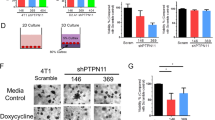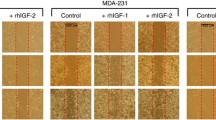Abstract
Previously, oncostatin M (OSM) has been shown to inhibit the proliferation of breast cancer cells in vitro. Circumstantial evidence, however, suggests that OSM could be involved in the development of a metastatic phenotype in vivo. We examined the effects of OSM on the proliferation and metastatic potential of the murine mammary carcinoma cell lines M6 (adenocarcinoma) and M6c (metastatic adenocarcinoma). OSM inhibits the proliferation of both cell lines by 43%, but also causes a loss of cell-cell and cell-substratum adhesion that culminates in cell detachment from monolayer culture. OSM treatment results in a 258% and 550% increase in the detachment of M6 and M6c, respectively, in 32 hours. This effect was abrogated by the selective Cox-2 inhibitor NS-398, and by the anti-inflammatory glucocorticoid dexamethasone. Exogenous prostaglandin E2 (PGE2) partially reverses NS-398's inhibition of OSM-induced cell detachment, indicating Cox-2 involvement. In addition, OSM induces the expression of Cox-2 mRNA, and of the 74 kDa form of Cox-2 protein. M6 and M6c cells detached by OSM are viable and will re-adhere and proliferate in the absence of OSM. OSM-detached cells (M6DET and M6cDET) were collected and maintained in culture and their invasiveness was assessed in vitro. Importantly, M6DET and M6cDET are both significantly more invasive that their respective parental cells. These data suggest that OSM could contribute to the development of a metastatic phenotype in vivo, which would render OSM unsuitable as a cancer therapy and suggest that OSM itself is a potential therapeutic target.
Similar content being viewed by others
References
Gomez-Lechon MJ. Oncostatin M: Signal transduction and biological activity. Life Sci 1999; 65: 2019–30.
Grant SL, Begley CG. The oncostatin M signaling pathway: reversing the neoplastic phenotype? Mol Med Today 1999; 5: 406–12.
Crichton MB, Nichols JE, Zhao Y et al. Expression of transcripts of interleukin-6 and related cytokines by human breast tumors, breast cancer cells, and adipose stromal cells. Mol Cell Endocrinol 1996; 118: 215–20.
Lopez MJ, Porter KA. Inflammatory breast cancer. Surg Clin North Am 1996; 76: 411–29.
Mantovani A, Bottazi B, Colotta F et al. The origin and function of tumor associated macrophages. Oncol Today 1992; 13: 265–70.
Aeed PA, Nakajima M, Welch DR. The role of polymorphonuclear leukocytes (PMN) on the growth and metastatic potential of 13762NF mammary adenocarcinoma cells. Int J Cancer 1988; 42: 748–59.
Welch DR, Schissel DJ, Howry RP, Aeed PA. Tumor-elicited polymorphonuclear cells, in contrast to 'normal' circulating polymorphonuclear cells, stimulate invasive and metastatic potentials of rat mammary adenocarcinoma cells. Proc Natl Acad Sci USA 1989; 86: 5859–63.
Bernard C, Merval R, Lebret M et al. Oncostatin M induces interleukin-6 and cyclooxygenase-2 expression in human vascular smooth muscle cells: Synergy with interleukin-1β. Circ Res 1999; 85: 1124–31.
Lahiri T, Laporte JD, Moore PE et al. Interleukin-6 family cytokines: Signaling and effects in human airway smooth muscle cells. Am J Physiol Lung Cell Mol Physiol 2001; 280: L1225–L32.
Ohata Y, Harada T, Fujii A et al. Menstrual cycle-specific inhibition of endometrial stromal cell proliferation by oncostatin M. Mol Human Reprod 2001; 7: 665–70.
Repovic P, Mi K, Benveniste EN. Oncostatin M enhances the expression of prostaglandin E2 and cyclooxygenase-2 in astrocytes: Synergy with interleukin-1β, tumor necrosis factor-α, and bacterial lipopolysaccharide. Glia 2003; 42: 433–46.
Khuder SA, Mutgi AB. Breast cancer and NSAID use: A meta-analysis. Br J Cancer 2001; 84: 1188–92.
Harris RE, Alshafie GA, Abou-Issa H, Seibert K. Chemoprevention of breast cancer in rats by celecoxib, a cyclooxygenase 2 inhibitor. Cancer Res 2000; 60: 2101–03.
Sharpe CR, Collet JP, McNutt M et al. Nested case control study of the effects of non-steroidal anti-inflammatory drugs on breast cancer risk and stage. Br J Cancer 2000; 83: 112–20.
Harris RE, Kasbari S, Farrar WB. Prospective study of nonsteriodal drugs and breast cancer. Oncol Rep 1999; 6: 71–3.
Lala PK, Al-Mutter N, Orucevic A. Effects of chronic indomethacin therapy on the development and progression of spontaneous mammary tumors in C3H/HEJ mice. Int J Cancer 1997; 73: 371–80.
Soslow RA, Dannenberg AJ, Rush D et al. COX-2 is expressed in human pulmonary, colonic, and mammary tumors. Cancer 2000; 89: 2637–45.
Hwang D, Scollard D, Byrne J, Levine E. Expression of cyclooxygenase-1 and cyclooxygenase-2 in human breast cancer. J Natl Cancer Inst 1998; 90: 455–60.
Parrett ML, Harris RE, Joarder FS et al. Cyclooxygenase-2 gene expression in human breast cancer. Int J Oncol 1997; 10: 503–7.
Ristimaki A, Sivula A, Lundin J et al. Prognostic significance of elevated cyclooxygenase-2 expression in breast cancer. Cancer Res 2002; 62: 632–5.
Fosslien E. Molecular pathology of cyclooxygenase-2 in neoplasia. Ann Clin Lab Sci 2000; 30: 3–21.
Connolly JM, Rose DP. Effects of fatty acids on invasion through reconstituted basement membrane ('Matrigel') by a human breast cancer cell line. Cancer Lett 1993; 75: 137–42.
Kakiuchi Y, Tsuji S, Tsujii M et al. Cyclooxygenase-2 activity altered the cell-surface carbohydrate antigens on colon cancer cells and enhanced liver metastasis. Cancer Res 2002; 62: 1567–72.
Tsujii M, Kawano S, DuBois RN. Cyclooxygenase-2 expression in human colon cancer cells increases metastatic potential. Proc Natl Acad Sci USA 1997; 94: 3336–40.
Attiga FA, Fernandez PM, Weeraratna MJ et al. Inhibitors of prostaglandin synthesis inhibit human prostate tumor cell invasiveness and reduce the release of matrix metalloproteinases. Cancer Res 2000; 60: 4629–37.
Nithipatikom K, Isbell MA, Lindholm PF et al. Requirement of cyclooxygenase-2 expression and prostaglandins for human prostate cancer cell invasion. Clin Exp Metast 2002; 19: 593–601.
Rozic JG, Chakraborty C, Lala PK. Cyclooxygenase inhibitors retard murine mammary tumor progression by reducing tumor cell migration, invasiveness and angiogenesis. Int J Cancer 2001; 93: 497–506.
Maroulakou IG, Anver M, Garrett L, Green JE. Prostate and mammary adenocarcinoma in transgenic mice carrying a rat C3(1) simian virus 40 large tumor antigen fusion gene. Proc Natl Acad Sci USA 1994; 91: 11236–40.
Holzer RG, MacDougall C, Cortright G et al. Development and characterization of a progressive series of mammary adenocarcinoma cell lines derived from the C3(1)/SV40 Large T-antigen transgenic mouse model. Breast Cancer Res Treat 2003; 77: 65–76.
Thomas B, Bird TA, Friend DJ. Oncostatin M and leukemia inhibitory factor trigger overlapping and different signals through partially shared receptor complexes. J Biol Chem 1994; 269: 6215–22.
Mosley B, DeImus C, Friend D et al. Dual oncostatin M receptors. J Biol Chem 1996; 271: 32635–43.
Morriser S, Patry C, Lora M, de Brum-Fernandes J. Regulation of cyclooxygenase-2 expression in bovine chondrocytes in culture by interleukin 1alpha, tumor necrosis factor-alpha, glucocorticoids, and 17beta-estradiol. J Rheumatol 1998; 25: 1146–53.
Otto JC, DeWitt DL, Smith WL. N-glycosylation of prostaglandin endoperoxide synthases-1 and-2 and their orientations in the endoplasmic reticulum. J Biol Chem 1993; 268: 18234–42.
Grant SL, Douglas AM, Goss GA, Begley CG. Oncostatin M and leukemia inhibitory factor regulate the growth of normal human breast epithelial cells. Growth Factors 2001; 19: 153–62.
Zarling JM, Shoyab M, Marquardt H et al. Oncostatin M: A growth regulator produced by differentiated histiocytic lymphoma cells. Proc Natl Acad Sci 1986; 83: 9739–43.
Horn D, Fitzpatrick WC, Gompper PT et al. Regulation of cell growth by recombinant oncostatin M. Growth Factors 1990; 2: 157–65.
Liu J, Spence MJ, Wallace PM et al. Oncostatin M-specific receptor mediates inhibition of breast cancer cell growth and down-regulation of the c-myc proto-oncogene. Cell Growth Diff 1997; 8: 667–76.
Douglas AM, Goss GA, Sutherland RL et al. Expression and function of members of the cytokine receptor superfamily on breast cancer cells. Oncogene 1997; 14: 661–9.
Zhang F, Cong L, Halfter H, Liu J. Delineating an oncostatin M-activated STAT3 signaling pathway that coordinates the expression of genes involved in cell cycle regulation and extracellular matrix deposition of MCF-7 cells. Oncogene 2003; 22: 894–905.
Douglas AM, Grant SL, Goss GA et al. Oncostatin M induces the differentiation of breast cancer cells. Int J Cancer 1998; 75: 64–73.
Tamm I, Kikuchi T, Cardindale I, Krueger JG. Cell-adhesion-disrupting action of interleukin 6 in human ductal breast carcinoma cells. Proc Natl Acad Sci USA 1994; 91: 3329–33.
Tamm I, Cardindale I, Krueger J et al. Interleukin 6 decreases cell-cell association and increases motility of ductal breast carcinoma cells. J Exp Med 1989; 170: 1649–69.
Zettl KS, Sjaastad MD, Riskin PM et al. Glucocorticoid-induced formation of tight junctions in mouse mammary epithelial cell in vitro. Proc Natl Acad Sci USA 1992; 89: 9069–73.
Percival MD, Bastien L, Griffin PR et al. Investigation of human cyclooxygenase-2 glycosylation heterogeneity and protein expression in insect and mammalian cell expression systems. Prot Exp Pur 1997; 9: 388–98.
Badache A, Hynes NE. Interleukin 6 inhibits proliferation and, in cooperation with an epidermal growth factor receptor autocrine loop, increases migration of T47D breast cancer cells. Cancer Res 2001; 61: 383–91.
Author information
Authors and Affiliations
Corresponding author
Rights and permissions
About this article
Cite this article
Holzer, R.G., Ryan, R.E., Tommack, M. et al. Oncostatin M stimulates the detachment of a reservoir of invasive mammary carcinoma cells: Role of cyclooxygenase-2. Clin Exp Metastasis 21, 167–176 (2004). https://doi.org/10.1023/B:CLIN.0000024760.02667.db
Issue Date:
DOI: https://doi.org/10.1023/B:CLIN.0000024760.02667.db




